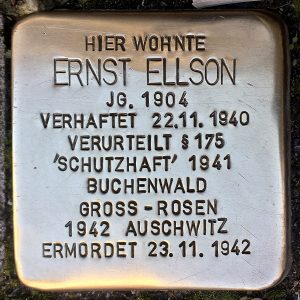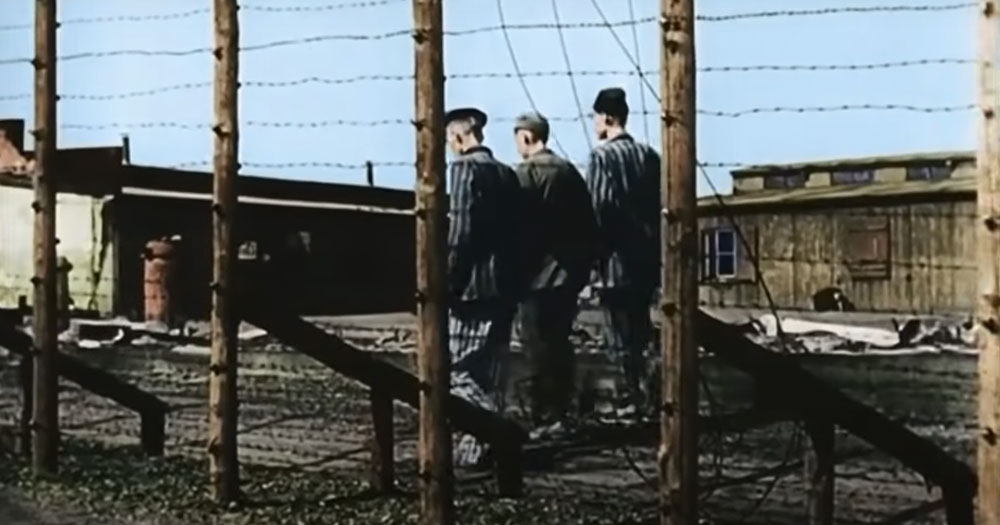Holocaust Remembrance Day was established by the United Nations to commemorate the six million Jewish victims of the Holocaust, as well as the other victims of the Nazi regime. Among them were the gay people who were arrested and killed in what is remembered as the most severe persecution of homosexuals in history. It was estimated that between 6,000 and 7,000 gay men were imprisoned in Nazi concentration camps and 98 of them were sent to Auschwitz.
Homosexuality in Germany had been illegal since 1871, but the law was made harsher in 1935 by the Nazi regime, with even simply “having homosexual fantasies” becoming illegal. Of those who were deported to camps, it is estimated that 60 per cent died. Many were executed, but many more died because of forced labour, malnutrition and the horrifying tortures they had to endure.
Moreover, the gay inmates were subject to unusually cruel treatment not only by the SS, but also by other fellow inmates who isolated them and considered them the lowest of the camp hierarchy. If they dared to approach other prisoners, they could be accused of trying to seduce them, as the common belief at the time was that homosexuality could be spread.
Today is #HolocaustMemorialDay – the international day to remember all those murdered during the Holocaust, under Nazi persecution of other groups, and in genocides that followed in Cambodia, Rwanda, Bosnia and Darfur.
Let's learn from the past for a better future. #HMD2022
— Holocaust Memorial Day Trust (@HMD_UK) January 27, 2022
After the Nazi regime had fallen, the law that criminalised homosexuality remained as one of the only laws from that era to be retained in its original form in West Germany. This meant that those who were freed from the horrors of the concentration camps would still be punishable for simply being gay. The law was then revised in 1969, but it took waiting until 1994 for it to be completely repealed.
Auschwitz was the largest of Nazi concentration and death camps and historians estimate that 1.1 million people died here. Of the gay people who entered Auschwitz, 51 perished in the camp. Although this is a small, often overlooked number compared to all the lives lost in that camp, their stories deserve to be heard. Read on to discover and remember them.
Freddy Hirsch
Moving: Google pay homage to Freddy Hirsch z"l gay teacher who saved hundreds of #Jewish #children in the #Holocaust. To mark his 105th b'day Google dedicated daily doodle to this brave educator to tell his unique story to millions of users in #Israel, #Germany and #Europe #LGBTQ pic.twitter.com/lFSobrpERl
— Eli Dror (@edrormba) February 12, 2021
Freddy Hirsch was a PE teacher, Jewish and gay. He was sent to Theresienstadt concentration camp first, where he began to look after and protect a group of children. Later, he was sent to Auschwitz where once again he became the children’s carer, saving so many of their lives. He soon learned that a large group of those children were to be gassed and he became part of a resistance movement inside the camp.
Hirsch died of an overdose when he was 28. Scholars speculated that he took his own life or that the overdose was caused by Jewish doctors who were scared that he was going to cause an uprising that would jeopardise their lives.
Karl Gorath
Karl Gorath was just 26 when his jealous lover denounced him as a gay man. He spent years in the concentration camp system until he was liberated from Auschwitz in 1945. But after liberation, he faced another set of difficulties. 1/5 pic.twitter.com/aTOQp4zSdu
— US Holocaust Museum (@HolocaustMuseum) June 7, 2019
After a jealous former lover denounced him to the Nazis, Karl Gorath was sent to the concentration camp at Neuengamme, where he was put to work as a nurse. His punishment for refusing to reduce the food rations for the inmates was to be sent to Auschwitz. Nine days before the camp was liberated, he was transported to Austria in freezing cold weather on a journey that lasted 11 days. He was finally liberated in 1945 only to be arrested again in 1946 and sentenced to five years in jail because homosexuality was still illegal.
In his memoirs, Gorath recalls two Poles, Tadeusz and Zbigniew, who became his lovers while in the camp. He speaks about his days with Zbigniew as the happiest of his life, as only once in his life had he encountered such a deep love and, he says, it was “here, in the camp, among all the misery surrounding us, never before, and never again – never more: I met the love of my life in Auschwitz”.
Ernst Ellson

Ernst Ellson was arrested in 1940 when a male sex worker reported him as a client to the police. He was sentenced to four months in jail for “perverted promiscuity” but on the day he was released, the Gestapo were waiting for him. The warrant they had was signed by one of the architects of the Final Solution, Reinhard Heydrich. He survived only five weeks in the horrors of Auschwitz.
Manfred Lewin
In @HolocaustMuseum collection: Gad Beck & Manfred Lewin, gay lovers persecuted by the Nazis https://t.co/xOUMNvVtKK https://t.co/6WqwzuU49Y pic.twitter.com/8EfIQFLNF8
— Raymund Flandez (@raymuseum) April 21, 2017
Manfred Lewin was a gay and Jewish man who was deported with his entire family. His boyfriend, Gad Beck, stole a uniform and managed to trick the guards at the detention centre into releasing his lover.
They walked out of the gates together, but Manfred couldn’t leave his family behind and went back inside. He died in Auschwitz aged 22. In a 2000 interview Gad Beck, who survived the war, remembered losing his “great, great love”.
Kitty Fischer’s saviour
In my latest video journalist and author Keith Howes recalls his interview with Holocaust survivor Kitty Fischer and his own recent visit to Auschwitz, Krakow and Warshaw. #Auschwitz #Krakow #Warshaw #KeithHowes #KittyFischer https://t.co/1fcK32IHu0 via @YouTube
— William Brougham (@WilliamBrougham) May 19, 2020
Kitty Fischer, a Jewish survivor of Auschwitz, has never known the name of the gay man who saved her life. When she met him, Kitty asked him what his pink triangle meant, as she didn’t know the meaning behind it.
The man smuggled food for the girl and her sister and contributed to her survival. It was also his suggestion to lie to the guards that ultimately saved her life and prevented her being sent to the gas chambers, as was planned. She told them that she could weave, as the man had advised, and she was sent to a factory where she was liberated in 1945.
These are only a few of the forgotten stories of the gay people who died in Auschwitz, which we were able to uncover thanks to Dr Anna Hájková‘s research into the queer history of the Holocaust. But many more of them lost their life in the camp including: Hermann Bartel, Erwin Schimitzek, Emil Drews, Max Gergia, Emil Sliwiok, August Pfeiffer, Walter Peters, Willi Pohl, Rudolf von Mayer, Willi Kacker, Oskar Birke, Otto Hertzfeld, Johann Majschek, Franz Ruffert, Richard Schiller, Josef Klose, Hugo Prabitzer.
Learn their names and remember, so that this can never happen again.
© 2022 GCN (Gay Community News). All rights reserved.
Support GCN
GCN is a free, vital resource for Ireland’s LGBTQ+ community since 1988.
GCN is a trading name of National LGBT Federation CLG, a registered charity - Charity Number: 20034580.
GCN relies on the generous support of the community and allies to sustain the crucial work that we do. Producing GCN is costly, and, in an industry which has been hugely impacted by rising costs, we need your support to help sustain and grow this vital resource.
Supporting GCN for as little as €1.99 per month will help us continue our work as Ireland’s free, independent LGBTQ+ media.
